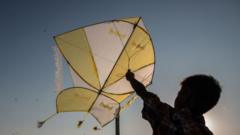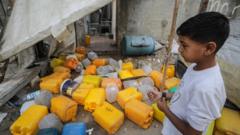**As the popularity of kite flying intersects with aviation safety concerns near Jakarta's airport, authorities struggle to balance cultural tradition with the need for secure air travel.**
**Kite Fighting Against Aviation: Indonesia's Aerial Dilemma**

**Kite Fighting Against Aviation: Indonesia's Aerial Dilemma**
**In Indonesia, the tug of war between children flying kites and airport authorities poses safety risks for aircraft.**
In a sun-soaked paddy field just two kilometers from Jakarta's bustling international airport, the vibrant colors of kites soar high above, competing with the steady roar of aircraft engines above. Children, like seven-year-old Atif, enthusiastically grip the strings, but they also remain vigilant for airport officials who seek to enforce rules against flying kites too close to flight paths. "Back then, I used to run away when they arrived," Atif recounts, "but I've built up the courage to stand my ground when they scold me."
Kite flying is a cherished pastime in Indonesia, particularly during the summer holiday season. However, authorities have recently heightened their warnings, citing potential dangers posed by kites that can interfere with airplane sensors or become entangled in engines—a situation they believe can lead to tragic accidents. Just earlier this month, a record 21 flights were disrupted over a three-day span at Soekarno-Hatta International Airport due to kites, according to AirNav Indonesia, with some flights having to divert and others abort landings altogether.
Putu Eka Cahyadi, head of the airport authority, emphasized to BBC reporters the pressing nature of these hazards, stating, “Kites are moving obstacles for planes and we cannot take that risk.” This concern is reinforced by past incidents: a helicopter crash in Bali last year and a close call involving plane engine damage from kite debris.
Despite the risks, young kite enthusiasts remain undeterred. Government officials have attempted to introduce alternative activities like soccer and badminton, yet kite flying remains deeply embedded in Indonesian culture, representing tradition that dates back generations. Experts, such as Asep Irawan from the Indonesia Kite Museum, recognize the significance of this cultural practice while stressing the imperative for caution, especially among children who may lack awareness of the risks.
Current regulations penalize individuals caught flying kites in hazardous zones near airports with fines reaching one billion Indonesian rupiah (about $61,000) or possible jail time up to three years. However, accidents related to kite flying aren’t confined to airstrips; within urban settings, kites can lead to dangerous distractions. Last year, an eight-year-old boy tragically lost his life while chasing a kite near a busy toll road.
In Jakarta, where urbanization has drastically reduced green spaces—more than 31% lost from 2000 to 2020—children question where else they could pursue their beloved hobby. Rasha, 17, a kite maker who has won local competitions, reflects, “There really aren’t many places left to fly. Other spots still sit close to the airport.” Despite warning and penalties, Rasha and his friends continue to meet in their makeshift kite community at the paddy field, determined to retain their cultural pastime. "It feels risky, but when you've lost your kites, fear tends to fade," he shares, highlighting the emotional connection they have to their kites and their passion.
Kite flying is a cherished pastime in Indonesia, particularly during the summer holiday season. However, authorities have recently heightened their warnings, citing potential dangers posed by kites that can interfere with airplane sensors or become entangled in engines—a situation they believe can lead to tragic accidents. Just earlier this month, a record 21 flights were disrupted over a three-day span at Soekarno-Hatta International Airport due to kites, according to AirNav Indonesia, with some flights having to divert and others abort landings altogether.
Putu Eka Cahyadi, head of the airport authority, emphasized to BBC reporters the pressing nature of these hazards, stating, “Kites are moving obstacles for planes and we cannot take that risk.” This concern is reinforced by past incidents: a helicopter crash in Bali last year and a close call involving plane engine damage from kite debris.
Despite the risks, young kite enthusiasts remain undeterred. Government officials have attempted to introduce alternative activities like soccer and badminton, yet kite flying remains deeply embedded in Indonesian culture, representing tradition that dates back generations. Experts, such as Asep Irawan from the Indonesia Kite Museum, recognize the significance of this cultural practice while stressing the imperative for caution, especially among children who may lack awareness of the risks.
Current regulations penalize individuals caught flying kites in hazardous zones near airports with fines reaching one billion Indonesian rupiah (about $61,000) or possible jail time up to three years. However, accidents related to kite flying aren’t confined to airstrips; within urban settings, kites can lead to dangerous distractions. Last year, an eight-year-old boy tragically lost his life while chasing a kite near a busy toll road.
In Jakarta, where urbanization has drastically reduced green spaces—more than 31% lost from 2000 to 2020—children question where else they could pursue their beloved hobby. Rasha, 17, a kite maker who has won local competitions, reflects, “There really aren’t many places left to fly. Other spots still sit close to the airport.” Despite warning and penalties, Rasha and his friends continue to meet in their makeshift kite community at the paddy field, determined to retain their cultural pastime. "It feels risky, but when you've lost your kites, fear tends to fade," he shares, highlighting the emotional connection they have to their kites and their passion.

















